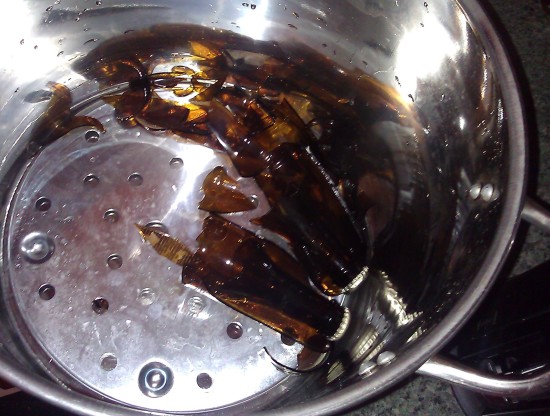Recently, I decided to bottle my hard cider. Like most hard ciders, when it finishes fermenting, you’re left with a Final Gravity (FG) of 1.000 and it tastes very dry. To make it taste more like cider, we back-sweeten.
In my case, I had brewed 3 gallons of hard cider and then added 3/4 of a gallon of sweet cider which gave me a new Specific Gravity reading of 1.015 (or thereabouts.) The perfect balance of sweet and dry! (IMHO)
At this point, I bottled the hard cider.
But now there was a danger lurking. 😮
Cider with active yeast in the bottle will resume fermentation and produce enough CO2 to create “bottle bombs”. Yup, the CO2 will build up in the bottles until they explode.
I had read elsewhere on the Intertubes that at some point, one should then pasteurize the bottles by putting them in a warm water bath of 160F (70C) for 10 minutes. This would completely kill off the yeast and keep the bottles appropriately carbonated.
Well, I tried this tonight…
I put 14 bottles in a bath of 160F water using a sturdy oven mitt to protect my hands and a hefty glass lid to put on top of the 5 gallon cooking pot. I also had taken the precaution of putting a canning rack on the bottom of the 5 gallon pot to keep the bottles off the bottom when I turned the stove on. The temperature quickly dropped to 130F because I put the cold bottles in. I turned the gas flame on and started re-heating the water to bring it back up to 160F.
At 155F, I started timing the 10 minute count-down.
Within a minute, one of the bottles exploded (thankfully contained by the strong lid on the pot.
I quickly cut the heat and waited. Four more minutes went by and another bottle exploded. This time I was looking right down into the pot through the glass lid when it exploded.
It scared the living daylights out of me. Thankfully, the sturdy glass lid (made by Calphalon) took the hit instead of my eyes. (Phew!)
At this point, I started pouring cold water into the cooking pot to rapidly cool the rest of the bottles down. No more bottle bombs after this.
So what happened?
I’m not entirely sure. Here are some thoughts:
- There was already too much CO2 in the bottles such that heating them up caused the CO2 to rapidly expand.
- The bottles (despite being separate from the bottom by sitting on a canning rack) were still too close to the bottom of the pot and got too hot, too fast.
- Some of the bottles were too weak to withstand proper pressure.
- Going from 60F to 160F that quickly was too much for the bottles.
- In order to quickly re-heat the bath, I had poured some boiling hot water down the inside of the pot.
Regarding point #1 — This is a distinct possibility. Although according to this gas law calculator the increase in pressure should have only been by 20%.
Regarding point #2 — I’m leaning towards this being part of the problem. When I put the canning rack in the bottom, I noticed that there wasn’t that much space from the bottom to the bottles. Technically, they weren’t touching the bottom, but it was awfully close. A gas stove might radiate more heat directly into the bottles.
Regarding point #3 — Only 2 out of the 14 bottles broke. The others were able to withstand the pressure. So clearly some bottles are stronger than others. But how does one easily tell the strong ones from the weak ones? I’m guessing the weight of a 12oz bottle probably has something to do with this. (Heavier bottles have thicker glass?)
Regarding point #4 — Maybe going from 60F to a 120F bath and then a 165F bath would have been better. The glass would have expanded more slowly and uniformly. That said, I don’t think this was the issue. If this were the case, the bottles would likely have exploded on initial insertion into the hot water. Still, pre-warming the bottles has some merit in that it doesn’t pull the heat down of the 160F bath to 130F. Instead it will only pull it down to, say, 150F.
Regarding point #5 — This may have contributed to the bottle bombs, though I have no way to be certain. Pouring boiling hot water in one region of the pot may have significantly (though temporarily) raised the temperature for that region. Again, the gas law calculator says that the increase in pressure should have only been 30% higher than the starting temperature.
If I were to do this again, I would take the appropriate steps as outlined here:
- Get a rack that sits at least 1″ off the bottom
- Pick stronger (heavier) bottles
- Pre-warm the bottles in a 100F bath for 3 minutes
- Transfer them to a 145F bath and hold for 20 minutes (lower and slower, but safer.)
- Definitely make sure there is a lid on the pot at all times (This was a very smart precaution, as it turns out.)
- Handle all bottles with an oven mitt or similarly strong glove



7 pings
Skip to comment form ↓